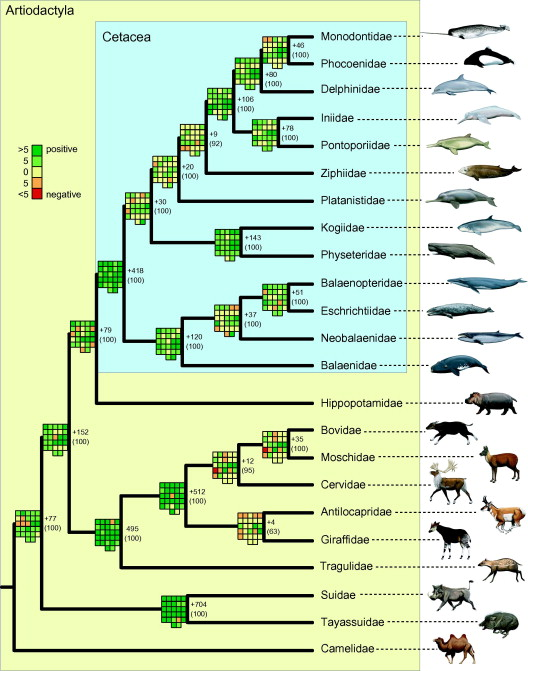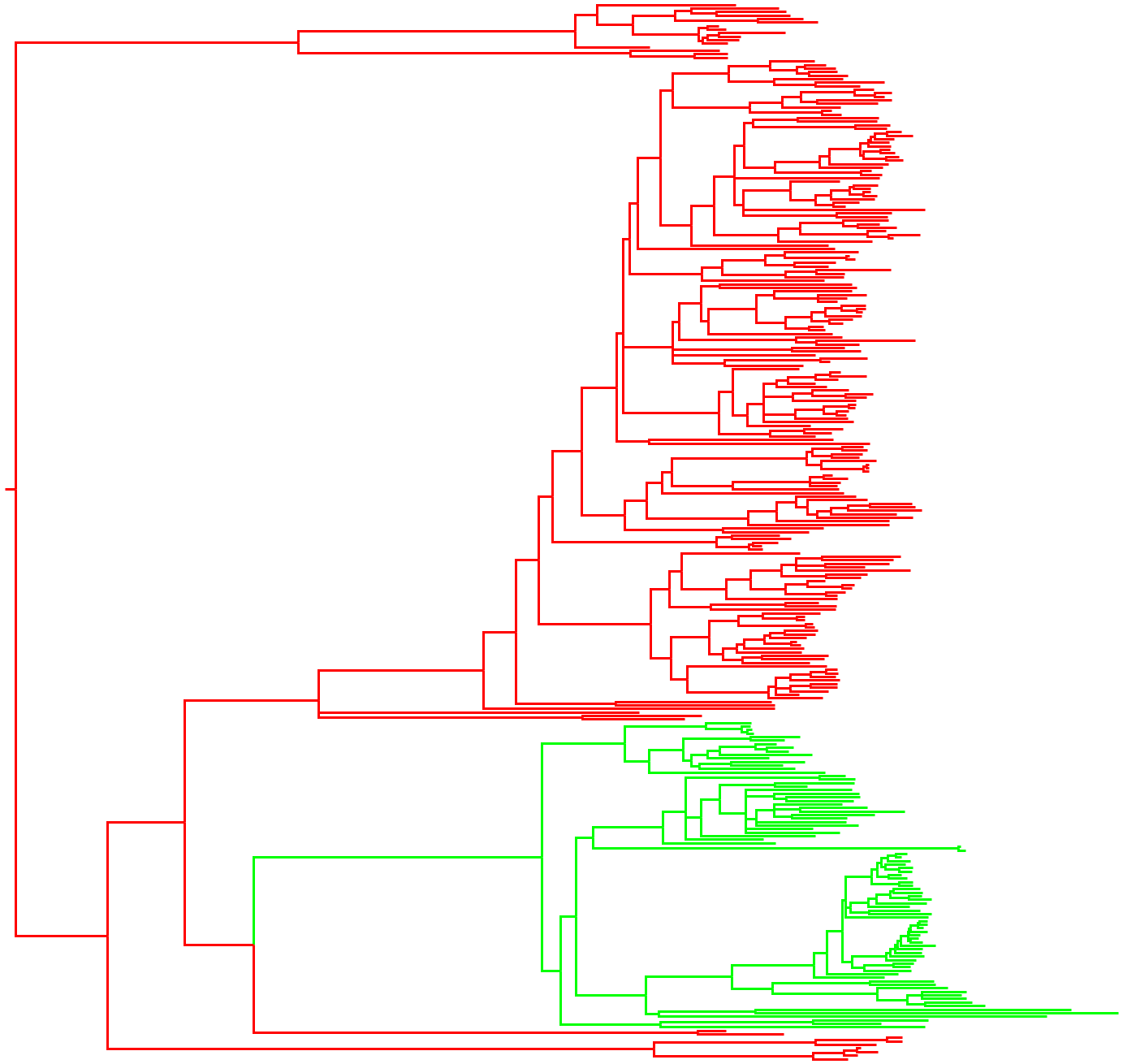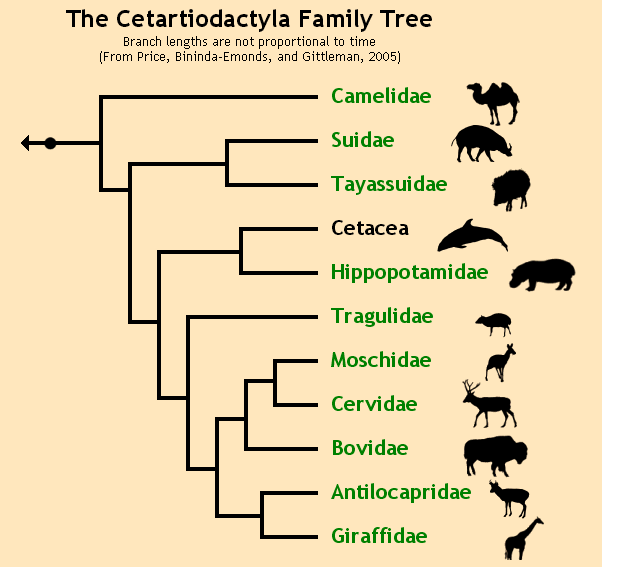Cetartiodactyla
Pygmy hippo
The Cetartiodactyla are a taxon ( a systematic group) of mammals, which is composed of two outwardly very different groups, the even-toed ungulates ( Artiodactyla ) and the Whales ( Cetacea). That these two groups form a monophyletic group ( descended from a common ancestor ), was confirmed by molecular genetic studies and is also supported by morphological made recently fossil finds. The cloven-hoofed animals, however, are now considered paraphyletic group, meaning that some representatives ( the hippos and presumably the ruminants) are more closely related to whales than with the other even-toed ungulates.
Features
Important synapomorphy (shared derived character ) the Cetartiodactyla is the special construction of the ankle bone, which has a joint role on both the upper and lower ends. Previously we thought this was an exclusive feature of the Artiodactyla, since it did not seem to be present also in fossil whales. ( In modern whales, there has been a regression of the hind limbs. ) In 2001 but was discovered that this particular talus was also present at the early fossil whales Pakicetus and Ichthyolestes ( Pakicetidae ) who lived during the late Eocene.
Two other common features are the three primary lung bronchus and fibroelastische penis, that is, the corpora cavernosa are well developed and the erection is primarily caused by sagging of Retraktormuskeln.
Otherwise, whales and even-toed ungulate have taken completely different directions in their evolution. While the whales probably the best adapted to the water marine mammals were the cloven developed for efficient runners in the country, thanks to the sophisticated digestive systems adapting itself (especially ruminants) outstanding on a plant-based diet.
System
Because of their relatively uniform body construction, the even-toed ungulate was considered long for a monophyletic group. Since the mid- 1990s, however, was occupied by a series of molecular studies indicate that the whales from artiodactyls developed and represent the hippos, the closest living relatives of whales. This, together with morphological studies, the earlier suspected origin of whales could be rebutted by the Mesonychia ( a carnivorous Huftiergruppe the early Cenozoic ).
The oldest fossils of Cetartiodactyla date from the early Eocene ( about 55 million years ago ). As these findings emerged in Europe, Asia and North America almost simultaneously, it is very difficult to determine the origin of Artiodactyla detail. These early forms are summarized in the group of Dichobunidae (or Dichobunoidea ) - her best-known and best -preserved representative is Diacodexis. There are small (initially only about hare large ) animals with slender build, long thin legs and a long tail. The hind legs were much longer than the front legs, not yet fully developed the typical toe structure and built the teeth niederkronig and easy. Already in the early to middle Eocene it came to radiation and to the emergence of numerous tribal lines. The oldest whales are occupied for 53 million years, also ancestors of the suborders of Artiodactyla (swine -like, calluses Ohler, ruminants) emerged in the Eocene.
Only the hippos appeared only around 15 million years ago. To explain the thus formed 40 million years long gap ( the common ancestor of whales and hippos must have lived before the first whales, ie around 55 million years ago), there is evidence that the Anthracotheriidae, one from the Eocene to the Pliocene widespread Paarhufergruppe, the sister group of the whales and the ancestors of hippos could be.
Within the recent representative results in the following suspected lineages:
Calluses Ohler ( Tylopoda )
Pig -like ( Suina )
Mouse deer ( Tragulidae )
Forehead weapons carrier ( Pecora )
Hippos ( Hippopotamidae )
Whales ( Cetacea)
In December 2007, Hans Thewissen, a professor in the Department of Anatomy, Northeastern Ohio Universities Colleges of Medicine and Pharmacy, in an alternative family tree hypothesis. His studies were in accordance with the closest relatives of early whales an extinct Paarhufergruppe called Raoellidae and both taxa together represent the sister group of the remaining even-toed ungulate is, including the hippo:
Other cloven-hoofed animals (including hippos )
Raoellidae (among Indohyus and Khirharia )
Whales
His findings come from the study of a new skeleton from the Kashmir region of Pakistan. It was a member of the genus Indohyus, which is assigned to the Raoellidae. Mainly due to a bony ring on the temporal bone ( petrosal ), the so-called involucre, which was previously known only from whales, as well as other features of the Vorbackenzähne ( premolars ) and the bone structure, the close relationship was established.










